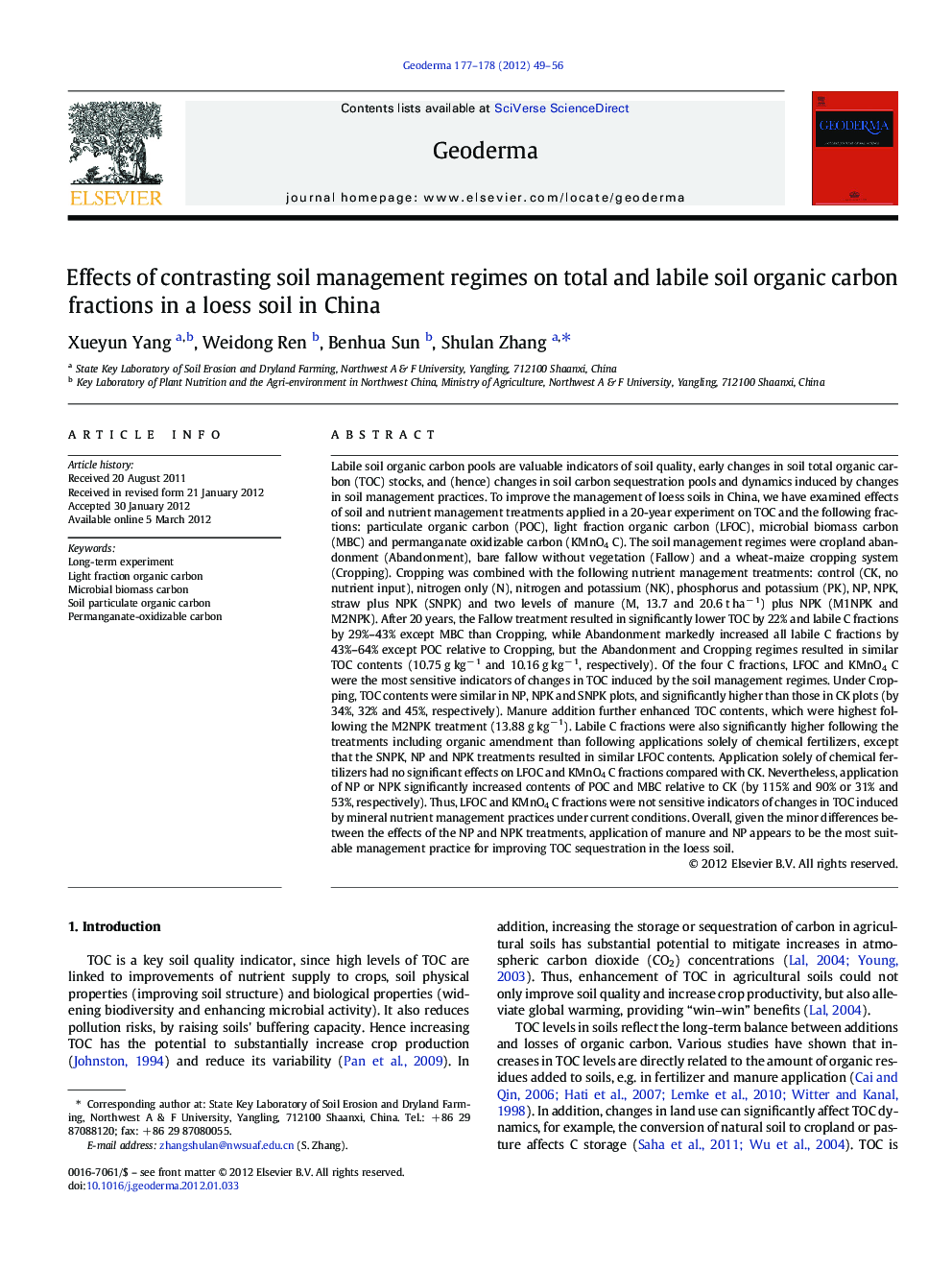| کد مقاله | کد نشریه | سال انتشار | مقاله انگلیسی | نسخه تمام متن |
|---|---|---|---|---|
| 4573871 | 1629499 | 2012 | 8 صفحه PDF | دانلود رایگان |

Labile soil organic carbon pools are valuable indicators of soil quality, early changes in soil total organic carbon (TOC) stocks, and (hence) changes in soil carbon sequestration pools and dynamics induced by changes in soil management practices. To improve the management of loess soils in China, we have examined effects of soil and nutrient management treatments applied in a 20-year experiment on TOC and the following fractions: particulate organic carbon (POC), light fraction organic carbon (LFOC), microbial biomass carbon (MBC) and permanganate oxidizable carbon (KMnO4 C). The soil management regimes were cropland abandonment (Abandonment), bare fallow without vegetation (Fallow) and a wheat-maize cropping system (Cropping). Cropping was combined with the following nutrient management treatments: control (CK, no nutrient input), nitrogen only (N), nitrogen and potassium (NK), phosphorus and potassium (PK), NP, NPK, straw plus NPK (SNPK) and two levels of manure (M, 13.7 and 20.6 t ha− 1) plus NPK (M1NPK and M2NPK). After 20 years, the Fallow treatment resulted in significantly lower TOC by 22% and labile C fractions by 29%–43% except MBC than Cropping, while Abandonment markedly increased all labile C fractions by 43%–64% except POC relative to Cropping, but the Abandonment and Cropping regimes resulted in similar TOC contents (10.75 g kg− 1 and 10.16 g kg− 1, respectively). Of the four C fractions, LFOC and KMnO4 C were the most sensitive indicators of changes in TOC induced by the soil management regimes. Under Cropping, TOC contents were similar in NP, NPK and SNPK plots, and significantly higher than those in CK plots (by 34%, 32% and 45%, respectively). Manure addition further enhanced TOC contents, which were highest following the M2NPK treatment (13.88 g kg− 1). Labile C fractions were also significantly higher following the treatments including organic amendment than following applications solely of chemical fertilizers, except that the SNPK, NP and NPK treatments resulted in similar LFOC contents. Application solely of chemical fertilizers had no significant effects on LFOC and KMnO4 C fractions compared with CK. Nevertheless, application of NP or NPK significantly increased contents of POC and MBC relative to CK (by 115% and 90% or 31% and 53%, respectively). Thus, LFOC and KMnO4 C fractions were not sensitive indicators of changes in TOC induced by mineral nutrient management practices under current conditions. Overall, given the minor differences between the effects of the NP and NPK treatments, application of manure and NP appears to be the most suitable management practice for improving TOC sequestration in the loess soil.
► Soil management regimes had significant effects on TOC and its fractions.
► Bare fallow resulted in significantly lower labile C fractions than Cropping.
► Abandonment markedly increased labile C fractions except POC relative to Cropping.
► Integrated application of manure and NPK greatly improved TOC and its labile pools.
Journal: Geoderma - Volumes 177–178, May 2012, Pages 49–56